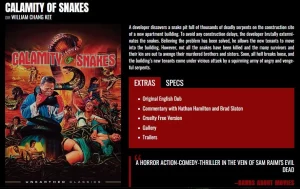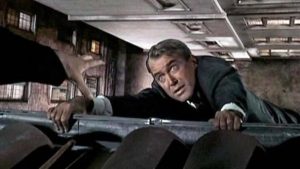 |
| Photos courtesy of Universal Pictures |
Dracula is arguably one of the most recognizable horror icons to ever grace the silver screen, having been depicted in a countless number of ways since the medium was created. While most people are familiar with this blood-sucking villain from Bram Stoker’s 1897 novel, fewer know about Dracula’s bug-devouring minion, and Chris McKay’s Renfield is here to change all of that in the most unconventional way possible.
While the Renfield in the Bram Stoker novel is a lunatic driven mad by his master’s mind control, the one we see in Renfield(Nicholas Hoult) is a far more complex character. He’s done Dracula’s (Nicolas Cage) bidding for centuries now thanks to powers bestowed upon him that are somehow bug-fueled, and while he’s been a mostly loyal servant, he can’t help but feel used, abused, and underappreciated at this point. He starts frequenting support groups for people in codependent relationships and begins to develop a conscience for all the wrongdoings he’s committed to satiate his master over the years.

Vowing to distance himself from the narcissist Dracula in order to gain his own identity and do what makes him happy, he cleans himself up, finds his own apartment, and starts to help people more than hurt them. He accidentally becomes entangled with a ruthless crime family, and through this connection he meets Rebecca (Awkwafina), a traffic cop who’s trying to live up to her father’s legacy on the police force. After a series of unfortunate circumstances, Rebecca and Renfield team up to fight the crime syndicate, rescue Rebecca’s kidnapped sister from them, and ultimately stop Dracula from taking over the world.
Renfield is a good time for the right audience – but it might not be who you might expect. While the allure of Dracula might bring horror fans to theaters in droves, the film plays out more like a late-90s action comedy with a healthy heaping of gore and sequences vaguely akin to that of a Guy Ritchie film, potentially leaving some people equally confused and disappointed. Moreover, Chris McKay has done Lego films prior to this, and somehow aspects of Renfield’s comedic first-person narration, heart-felt inner conflict, and the overall pacing do not make this surprising at all to learn: they genuinely feel like they could be straight from a CG animation film like The Lego Movie. It’s strangely cute and wholesome despite all the bloody mutilations we witness. None of these aspects make the film necessarily bad, but much like Renfield himself, it suffers from a bit of an identity crisis because of this. For accepting filmgoers who like to laugh, don’t mind some suspension of disbelief, and can forgive some odd genre jumps, it’s an entertaining adventure from beginning to end.

Every lead actor sinks their teeth into their roles (pun intended) and it helps elevate the film from what could easily be forgettable without its strong cast. Nicholas Hoult conveys both a vulnerability and strength that add dimension to the character of Renfield, making him immediately sympathizable despite his dark past. Awkwafina does what she does best, bringing a humorous, down-to-earth approach to Rebecca, but the character is written so flat that it doesn’t showcase her comedic talents nearly well enough. Nicolas Cage hams it up as Dracula, and for anyone who knows his penchant for Expressionist horror films like Nosferatu, this feels like a role he was born to play (in his mind at the very least, but probably many others’ too). Ben Schwartz is an added bonus as the bratty, incompetent crime family son Teddy, feeling also very much in his element in this role.
Renfield is also an aesthetic delight in many regards. Dramatic, high-contrast lighting with highly saturated hues set the stage for some attention-grabbing shots that are compelling to watch. Many of the set designs are inspired as well: from the New Orleans night club with a monster head at its threshold to Dracula’s shadowy, underground lair that is stylishly adorned with copious amounts of blood bags, the film is a visual feast. Topping it off, Dracula’s makeup and costume designs are a pleasure to behold, adding horror, majesty, and a bit of modern glamor to the character. There is also a delightful visual dichotomy between Renfield’s newly chosen pastel color palette and Dracula’s overbearing, monochromatic dark presence.

Nevertheless, some issues with the exposition and overall storytelling take the film down a notch. The film wastes no time getting into the main action, almost to a fault in this instance. The manner in which Renfield gets the audience abreast to his history with Dracula feels rushed, when it could have eased into it more fluidly and felt less abrasive in its approach. The way we learn about Rebecca’s past also comes out in some clunky dialogue, and her overall relationship with her sister feels like somewhat of a flimsy excuse to have a B story and serve as a catalyst for other necessary plot points that are more interesting. Many aspects of the crime family’s side story also feel rushed and simply there because they had to be, not adding much to the main narrative. Out of all the strange multiple identities this film has, the cop/crime boss story feels especially weak and off-base.
Renfield is often too many things at once while simultaneously not enough of any single thing, but it’s a bloody mess of a good time regardless. Abandon all expectations at the door and you might just leave feeling pleasantly entertained. Otherwise, you might end up leaving the theater scratching your head and thirsting for something else.
—Andrea Riley



